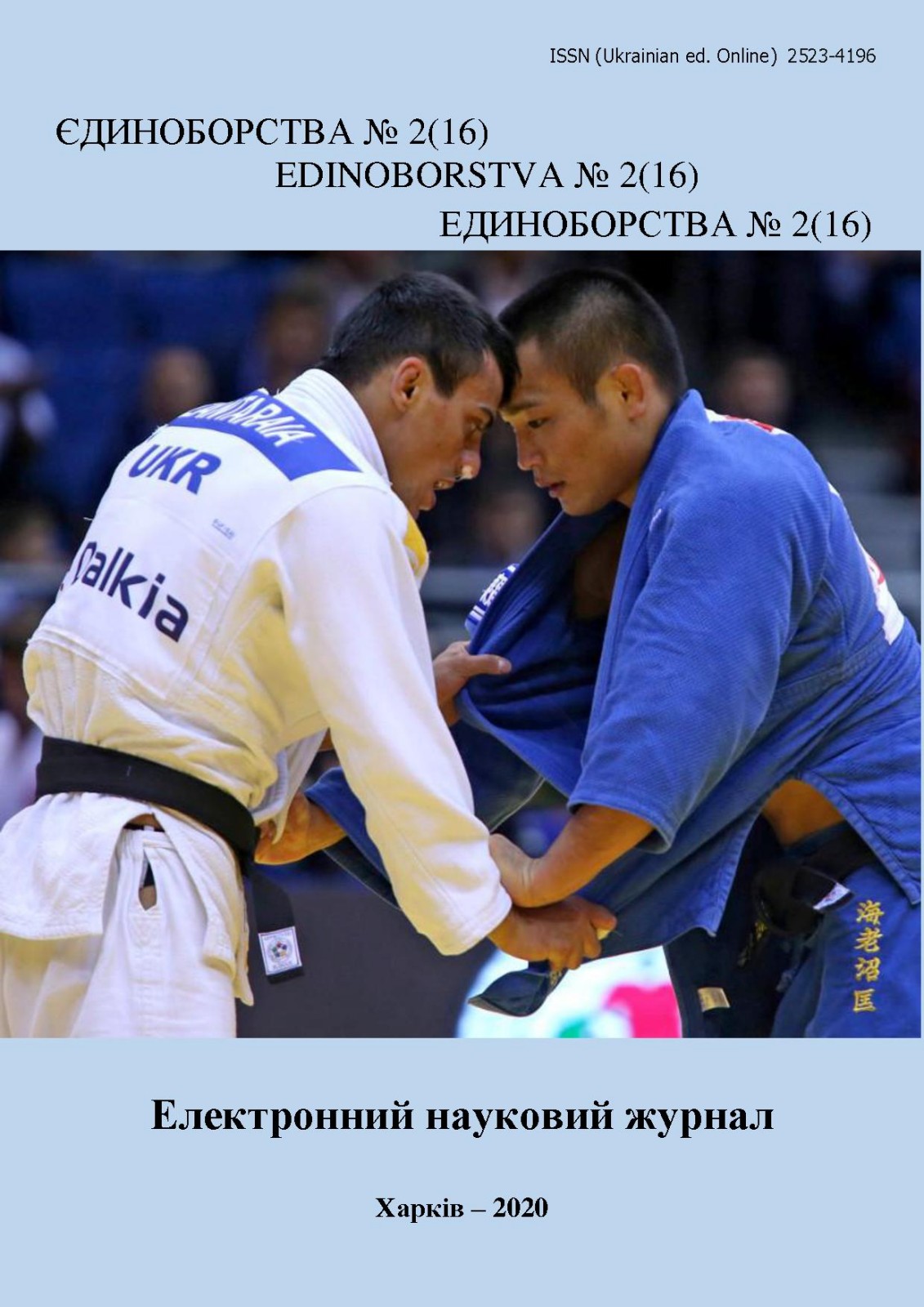The dynamics of the development of flexibility of judokas 13-14 years
DOI:
https://doi.org/10.15391/ed.2020-2.02Keywords:
judo, flexibility, active flexibility, passive flexibility, means, dynamics, research, developmentAbstract
Purpose: to study the dynamics of the development of flexibility of young judokas. Material and methods. During work, the following research methods were used to solve the tasks: analysis and generalization of scientific and methodological literature; pedagogical observation; pedagogical testing; methods of mathematical statistics. The study of the dynamics of the development of flexibility of young judokas was carried out using the following tests: «Raising straight arms up from a supine position, arms forward» (cm); «Torso forward while standing on the g / bench» (cm); «Longitudinal twine» (city); «Bridge» (cm). Results: studying the scientific and methodological literature on the problem of the development of flexibility in judo, a selection of exercises was carried out to develop active and passive flexibility of judo. After the implementation of the selected sets of exercises in the training process to develop the flexibility of young judokas, changes in the tested indicators were established. So, in the test «Leaning straight arms up from the supine position, arms forward», the flexibility index increased from 22,5 cm at the beginning of the study to 25,3 cm at the end of the study, in terms of percentages, the flexibility indicator increased by 12,4 % In the test «Torso forward in a standing position on a bench / bench», at the beginning of the study, the flexibility indicator averaged 11,42 cm, at the end – 14,92 cm. In terms of percentages, the flexibility indicator increased by 29,7 %. In the «Longitudinal twine» test, the indicator at the beginning of the training year in the group was 171 degrees, at the end of the study period - 178 degrees, the difference in these indicators was only 7 degrees, but these differences are very significant and statistically significant (t=7,53 at p<0,05). In the Bridge test, the increase in results was 7,2 %. Conclusions. A feature of the educational process of young judokas was the use of selected sets of exercises for the development of different types of flexibility based on the analysis of scientific and methodological literature. Analysis of the dynamics of the development of flexibility of young judokas showed that statistically significant differences in all indicators are observed between the beginning and the end of the study (p<0,05). Since in the study group attention was focused on the development of both passive and active flexibility, more significant changes are explained precisely by the effect of the accentuated development of flexibility.
References
Агеєв, П. М., & Запольский, Д. П. (2017). Дзюдо як засіб розвитку фізичних якостей студентів вищих навчальних закладів. Науковий часопис. Науково-педагогічні проблеми фізичної культури (фізична культура і спорт), 4 (85), 7-10. http://enpuir.npu.edu.ua/handle/123456789/20628.
Алексєєв, А. Ф., Ананченко, К. В., & Бойченко, Н. В. (2014). Теорія та методика викладання дзюдо та самбо: навч. посіб. для студенів 3 курсу (за кредитно-модульною системою). ХДАФК, Xарків.
Бавыкин, Е. А., & Коростелев, Е. Н. (2017). Физическая подготовка в единоборствах. Научные исследования и разработки в эпоху глобализации, 52-55.
Бойченко, Н. В. (2007). Пути повышения эффективности тренировочного процесса в восточных единоборствах. Физическое воспитание студентов творческих специальностей, 2, 148-150.
Бойченко, Н. В., & Голубничій, Р. В. (2016). Особливості фізичної підготовки спортсменок, що займаються дзюдо. Єдиноборства, 11-13.
Бойченко, Н. В., Станкевич, Б., & Дрозд, М. С. (2014). «Контроль за станом підготовленості борця». Проблемы и перспективы развития спортивных игр и единоборств в высших учебных заведениях, 1, 14-17.
Бріскін, Ю., Корягін, В., & Блавт, О. (2016). Технологічне забезпечення об’єктивного оцінювання гнучкості. Physical Education, Sports and Health Culture in Modern Society, (4(20), 406-411. Retrieved from https://sport.eenu.edu.ua/index.php/sport/article/view/681.
Ермаков, С. С., Тропин, Ю. Н., & Бойченко, Н. В. (2016). Специальная физическая подготовка квалифицированных борцов. Единоборства, 20-22.
Капінос, Д. В. (2014). Розвиток гнучкості та її вплив на досягнення юних кікбоксерів у змаганнях. Науковий пошук молодих дослідників. Збірник наукових праць студентів.—Луганськ, (9), 46-51.
Кощеєв, О., & Марченко, А. (2013). Особливості методики розвитку гнучкості спортсменів 8-10 років у тхеквондо за допомогою стретчінгу. Молода спортивна наука України, 17, т. 1, 87 - 91.
Кривошапкин, П. И., & Подливаев, Б. А. (2001). Методика физической подготовки юных борцов с акцентом на развитие гибкости. Спортивные единоборства на рубеже столетий: Пути и перспективы развития, 187-200.
Мазур, В. Й., & Петров, А. О. (2018). Методичні особливості розвитку рухових здібностей юних борців дюсш в тренувальному процесі. Вісник Кам’янець-Подільського національного університету імені Івана Огієнка. Фізичне виховання, спорт і здоров’я людини, 47-54.
Масалкін, М. Г., Корюкаєв, М. М., Масалкин, М. Г., & Корюкаев, Н. Н. (2017). Особливості розвитку фізичних якостей у борців-дзюдоїстів на початковому етапі тренувальної діяльності. Науковий часопис. Науково-педагогічні проблеми фізичної культури (фізична культура і спорт), 11 (93) 17, 70-73.
Огієнко, П. М., Бойкова, А. О., Чайко, В. М., Якуш, О. А., & Давидова, Н. А. (2008). Особливості розвитку гнучкості дівчат 15-17 років, які займаються спортивною боротьбою. Вісник, 198.
Паламарчук, Ю. Г. (2013). Удосконалення фізичної підготовленості дзюдоїстів 10-12 років з урахуванням їх конституційних особливостей. (Автореф. дис. … канд. наук з фіз. вих. і спорту). Київ, Україна.
Саєнко, В. Г., Палатов, М. А., & Лі, Ц. (2009). Взаємозв’язок показників координаційних здібностей і гнучкості у ушуїстів високої кваліфікації. Педагогіка, психологія та медико-біологічні проблеми фізичного виховання і спорту.–Харків: ХДАДМ (XXПІ), (9), 118-120.
Санжарова, Н. М., & Попова, М. В. (2013). Вплив засобів тхеквондо на рівень розвитку гнучкості хлопчиків молодшого шкільного віку. Актуальні проблеми фізкультурної освіти, (8), 38-40.
Тропин, Ю. Н., & Бойченко, Н. В. (2017). Содержание различных сторон подготовки борцов. Единоборства, 79-83.
Фиринская, Е. А. (2011). Значение гибкости в тренировочной деятельности дзюдоисток. Физическое воспитание студентов, 2, 106-108.
Шуба, Л. В., & Шуба, В. В. (2016). Розвиток загальної та спеціальної фізичної підготовленості хлопців 7–9 років які займаються дзюдо. Валеологія: сучасний стан, напрямки та перспективи розвитку, 266.













